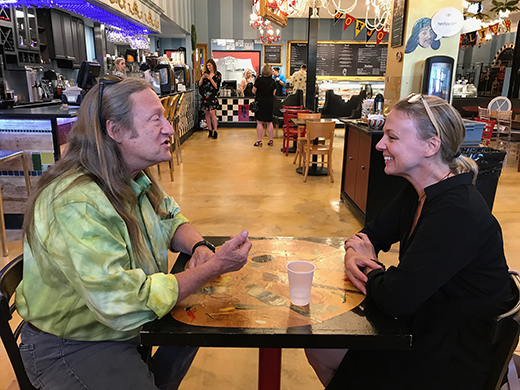
Doug Leunig and Marianne Huebner talk about the therapeutic power of art. Huebner currently works at Hopeway Foundation in Charlotte, N.C., as an art therapist serving adults with mental illness.
By Marianne Huebner
A few years further back than I like to admit, I went to a mile-marker class reunion. It was there where my career as an art therapist took center stage like a bearded lady at a carnival. People lined up with questions and uncomfortable looks, and I had an inclination to start charging admission fees.
I don’t mind the questions. In fact, I rather like the curiosity that being an art therapist brings out in people. I have been asked to analyze art made by famous artists, cousins and children. I have been asked if I paint on people such as “If a person is feeling sad would you paint them blue because they are feeling blue?” and “Does art therapy make art better? How?”
All these and more remind me that I chose a career that is outside the mold of standard career choices and that the concept of it is quite foreign to most people.
Art therapy uses creativity as part of the therapeutic process to help people move toward a desired outcome. For the client, skill is not a prerequisite. One need not have any perceived artistic ability, talent, or creative inclination to benefit from art therapy. Having been in the field for a while now, I have found that many people, mainly adults, aren’t necessarily even willing to start the process. They participate with great trepidation and come out the other side of art therapy moved, surprised, and often grateful for the experience.
Art therapy uses creative processes such as painting, drawing, collage, printmaking, sculpture, ceramics, writing and craft as an integrated approach to therapy. Art therapists are master’s level therapists, licensed by a credentialing board, who work with people of all ages from children to adults, from Alzheimer’s patients to those with anxiety, from the depressed to the suppressed or marginalized, from veterans with PTSD to civilian folk who are looking for more meaning in their life. Art therapy is truly for everyone.
The creative process is cathartic. It has a way of releasing emotion through color, shape and line and allows one to self-express. Creativity is also a mindful activity as well as an empowering one. Through choice, mark making, and intense focus, the creative process shifts the mind into awareness and a type of stillness simultaneously. It can take invisible thoughts and make them tangible and touchable by putting them to paper. The creative process can take the story that lives inside someone and place it outside so they can learn to control it or change it. Many times in life there are events for which people have no words and they can be saddled with a story that feels like it cannot be verbalized. The adage “a picture paints a thousand words” is a truism that applies to the way that art therapy can help a person navigate those wordless experiences.
As we like to say in the art therapy field, when words fail, art speaks. The creative process can be beneficial to well-being and to greater understanding of who you are and how you want to be in the world.
For more information about art therapy and to find an art therapist near you visit: www.arttherapy.org.

Recent Comments